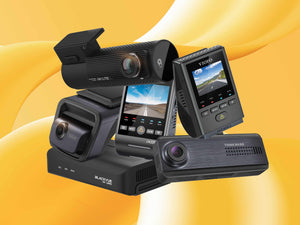Do I need one if I am a rideshare driver?
What is an IR Dash Cam?
Accessories to Get the Most Out of Your Dash Cam
Find the dash cam accessories you need to take your dash cam to the next level. Here at BlackboxMyCar, we offer our customers a variety of different accessories, cables, add-ons and mounts for your current wi-fi dashboard camera to ensure your device works at its best.
From dash cam adhesive tapes and suction cup mounts, to mini usb or micro USB cables, to extra dash cam battery pack, we have the accessory you need.
What is an IR Dash Cam?
Some people call it an in-cabin dash cam, others call it a night vision dash cam. Either way, the IR dash cam is a two-channel dash cam system that comes with a front-facing camera and a secondary camera that comes fitted with infrared lights for in-cabin recording.
IR dash cams utilizes the infrared light to invisibly illuminate dark vehicle interiors at night. Traditional dash cams would not perform well in extreme poor-lit environments, but thanks to the infrared technology, an infrared camera can offer crystal clear images even in pitch black environments, making it is the best dash cam solution for rideshare users, such as for Uber, Lyft, or for commercial use, such as fleet managers.
An IR dash cam is setup with a regular front-facing unit, and a secondary unit that records the interior of your vehicle.
Can Uber and Lyft Drivers Own Dash Cams?
Uber allows driver-partners to install and use video cameras, dash cams, or other recording devices to record riders for purpose of fulfilling transportation services. For more information, visit the official Uber website.
Lyft also allows drivers to install and use video cameras but states that depending on local regulations, the use of dashboard cameras and other recording devices during rides may not be allowed Some cities or provinces may require signage making known the presence of recording devices, while other regions may not allow recording devices at all. For more information, visit the official Lyft website.
Built for Commercial Truck Drivers
IR dash cams are also useful for commercial truck users or fleet managers, whether that’s used to monitor drivers or to record the rear of the vehicle (often driven at night time).
This is an excellent tool in analyzing driver behavior, capturing events including sleeping at the wheel, being on their phone, or exhibiting dangerous maneuvers. IR dash cams have proven to save fleet managers thousands of dollars in the potential damage that their employees would have caused to their commercial duty vehicles due to negligence.
Most importantly, dash cam footage can literally save a commercial trucking company from going out of business as the authorities do suspend a business license if dangerous driving behaviours are exhibited continuously.
How an IR Dash Cam Works
Passengers can easily make false claims against drivers, as can other parties if you get involved in an accident. The principle for owning a infrared camera is the same as having a regular dash cam - you may not use it all the time but when something happens, such as a false accusation from a passenger, then you will be very happy that you do have an infrared dash cam.
Now, imagine if these scenarios happened at night, in areas with very poor lighting. IR cameras use built-in infrared lights, filters and light sensors to enable video recording in extreme poor-lit situations. So, while traditional dash cams would not perform well under these conditions an infrared camera can offer crystal clear images even in pitch black environments.
An IR dash cam in your vehicle will help you in whatever situation you're in. So what are you waiting for? Explore our collection of IR dash cams today.
If you have any further questions, comments or suggestions, then don't hesitate to reach out to our product experts today!

